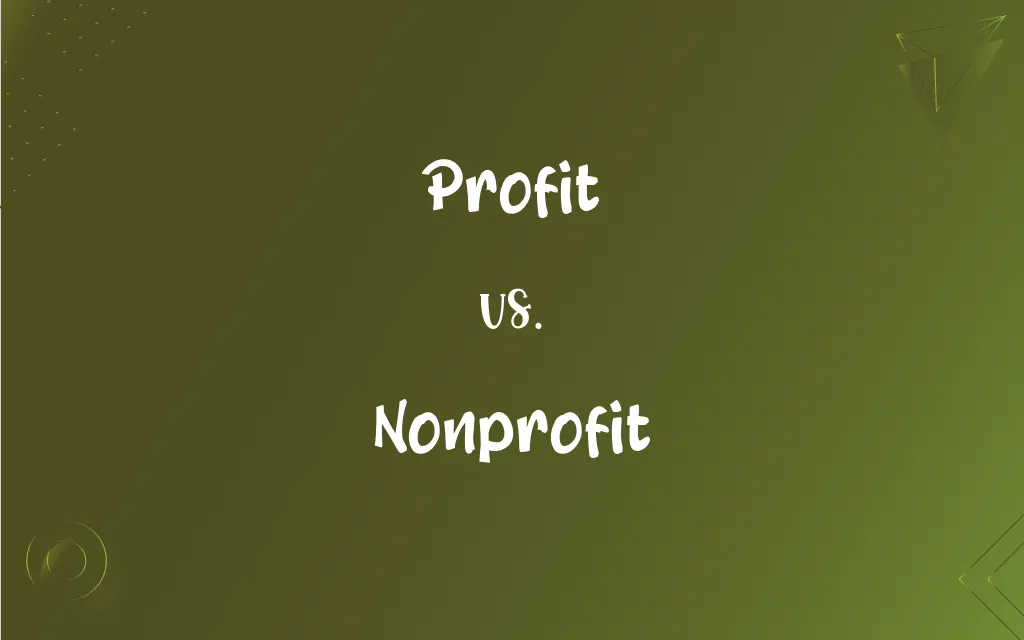Profit vs. Nonprofit: What's the Difference?
Edited by Aimie Carlson || By Harlon Moss || Published on November 13, 2023
Profit organizations aim for financial gain; nonprofit organizations prioritize a mission over monetary benefits.

Key Differences
Profit and nonprofit organizations have contrasting objectives and operational modalities. A profit organization's primary goal is generating revenue exceeding its expenses, ensuring stakeholders and owners obtain financial benefits. In contrast, nonprofit organizations work towards a specific mission, channeling any excess funds back into the organization to further their cause.
When looking at a profit organization, one typically finds a structure driven by revenue, sales, and market shares. Their strategies and operations revolve around generating financial gains. Nonprofit entities, however, function differently. Even though they might generate revenue, these funds are reinvested into their mission rather than distributing them as dividends or bonuses.
Profit businesses usually exist in commercial sectors, providing goods or services to consumers. Their ultimate goal is to ensure a return on investment for shareholders or owners. Nonprofit entities, conversely, can operate in various sectors, such as education, health, or charity, without the intent of distributing earnings to any individual or group.
It's essential to understand that while profit entities pay taxes on their earnings, nonprofit organizations often enjoy tax-exempt status. This exemption is due to their charitable, educational, or similar missions benefiting society. Lastly, while profit enterprises reward their stakeholders financially, nonprofits aim to make societal impacts, reflecting their commitment to community welfare over monetary gains.
Comparison Chart
Primary Goal
Financial gain
Mission fulfillment
ADVERTISEMENT
Use of Revenue
Distributed as dividends or bonuses
Reinvested in the mission
Tax Status
Taxable
Often tax-exempt
Examples
Retail businesses, tech companies
Charities, educational institutions
Beneficiaries
Shareholders/Owners
Community/Society
Profit and Nonprofit Definitions
Profit
Advantage or benefit derived from something.
Reading daily brings the profit of knowledge.
ADVERTISEMENT
Nonprofit
Not making or conducted primarily to make a profit.
The nonprofit event aimed to raise awareness about mental health.
Profit
A positive financial return in business.
She sold the property at a significant profit.
Nonprofit
Operating for reasons other than making a personal profit.
The nonprofit hospital provides care irrespective of a patient's ability to pay.
Profit
A financial gain, especially the difference between the amount earned and spent.
The company reported a profit of $1 million this quarter.
Nonprofit
Relating to an organization that reinvests its revenues into its mission.
The nonprofit art gallery showcases works from emerging artists.
Profit
The monetary surplus left after deducting expenses.
After all bills were paid, the profit amounted to $500.
Nonprofit
An organization that uses its surplus revenues to further its purpose rather than distributing them as profit or dividends.
The animal shelter is a nonprofit dedicated to rescuing homeless pets.
Profit
Excess of returns over expenditure in transactions.
The bookstore saw a profit in the holiday season.
Nonprofit
Serving a public or mutual benefit other than the pursuit of profits for owners or investors.
The nonprofit foundation grants scholarships to deserving students.
Profit
An advantageous gain or return; benefit.
Nonprofit
Not seeking or producing a profit or profits
A nonprofit organization.
Profit
Financial gain from a transaction or from a period of investment or business activity, usually calculated as income in excess of costs or as the final value of an asset in excess of its initial value.
Nonprofit
An organization, such as a charity, that does not seek or produce a profit
Donated money to local nonprofits.
Profit
To make a gain or profit.
Nonprofit
Not seeking to produce a profit a financial gain.
Nonprofit
Ellipsis of nonprofit organizationan organization that exists for reasons other than to make a profit, such as a charitable, educational or service organization.
Nonprofit
Not commercially motivated
FAQs
Do profit organizations aim for financial gain?
Yes, profit organizations prioritize financial gains.
Are all nonprofit organizations tax-exempt?
Not all, but many nonprofit organizations qualify for tax-exempt status.
Are all charities nonprofits?
While most charities operate as nonprofits, not all nonprofits are charities.
Can a profit company support charitable causes?
Yes, profit companies can support charitable causes, but their primary aim remains financial gain.
Do nonprofit organizations generate no money at all?
Nonprofit organizations can generate revenue, but they reinvest it in their mission.
Is the main goal of profit organizations to benefit shareholders?
Yes, profit organizations aim to provide returns to shareholders or owners.
Can a nonprofit organization have paid employees?
Yes, nonprofit organizations can have paid staff.
Are nonprofit organizations always charitable in nature?
Not always. Nonprofits can operate in sectors like education, health, or arts without being strictly charitable.
Can profit organizations enjoy tax benefits?
Profit organizations pay taxes on earnings, but they may avail certain deductions and benefits.
Are profit organizations inherently bad?
No, profit organizations are not inherently bad; they play a vital role in economies and job creation.
Are membership associations considered nonprofit?
Many membership associations operate as nonprofits, but their structure determines their status.
Can both profit and nonprofit organizations have a global presence?
Yes, both profit and nonprofit organizations can operate internationally.
Do nonprofits have stakeholders?
Yes, but unlike profit entities, the stakeholders do not receive financial returns.
What drives a profit company's strategies?
Financial gains and market shares often drive profit companies' strategies.
What is the primary difference between profit and nonprofit organizations?
Profit organizations aim for financial gains, while nonprofits prioritize a mission over monetary benefits.
How do nonprofit organizations sustain their operations?
Nonprofits sustain through donations, grants, and revenue-generating activities aligned with their mission.
Do nonprofit organizations aim for societal impact?
Yes, nonprofits prioritize societal impact over monetary gains.
Can a nonprofit organization make a profit?
Yes, but the profit is typically reinvested in the organization's mission.
Do profit companies always distribute their earnings?
Not always. They may reinvest, save, or distribute based on various factors.
Can a profit business convert to a nonprofit?
Yes, with legal and structural changes, a profit business can become a nonprofit.
About Author
Written by
Harlon MossHarlon is a seasoned quality moderator and accomplished content writer for Difference Wiki. An alumnus of the prestigious University of California, he earned his degree in Computer Science. Leveraging his academic background, Harlon brings a meticulous and informed perspective to his work, ensuring content accuracy and excellence.
Edited by
Aimie CarlsonAimie Carlson, holding a master's degree in English literature, is a fervent English language enthusiast. She lends her writing talents to Difference Wiki, a prominent website that specializes in comparisons, offering readers insightful analyses that both captivate and inform.








































































